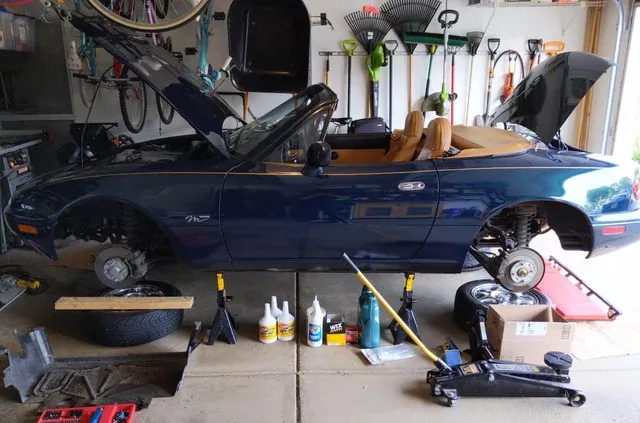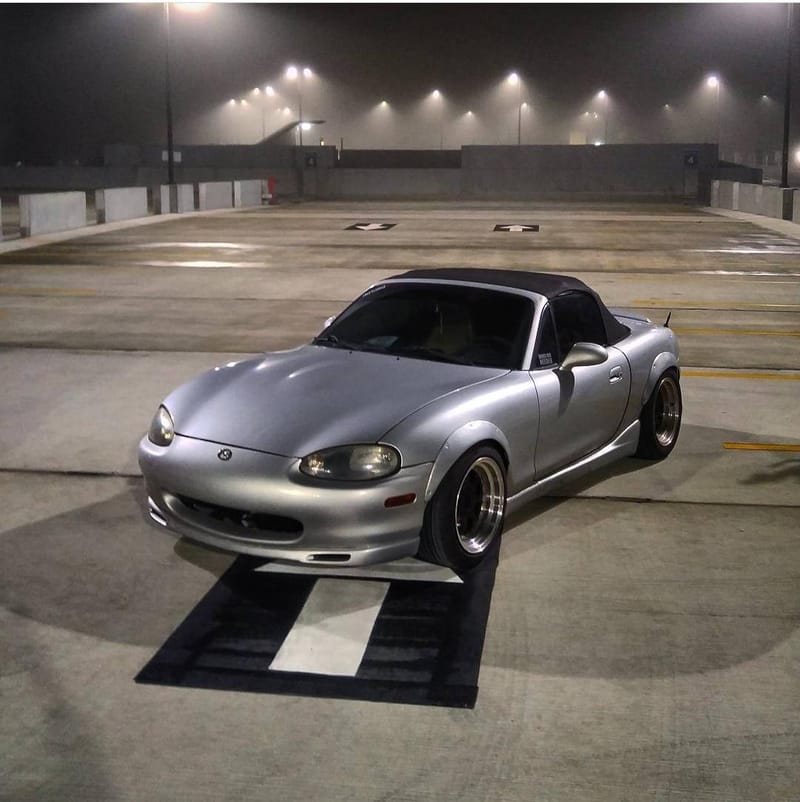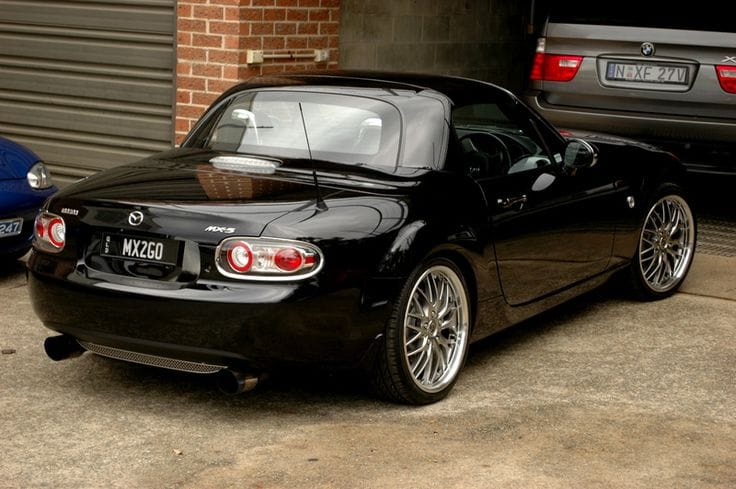When Shoould I ____? an NA Miata Maintenance Schedule Guide
Owning a Classic Miata is all about sticking to a smart, generation-specific service rhythm. This guide combines factory intervals with real-world tips, covering essentials. Follow this roadmap to keep your classic roadster reliable and fun for years to come.

If you drive an NA Miata, daily or on sunny Sundays, having a predictable, first-gen–specific maintenance rhythm saves money and drama. This guide blends factory schedules with owner-proven habits so you can plan service by time and mileage, and it calls out NA-only quirks like shifter turret oil, early 1.6 short-nose crank checks, and those infamous soft-top drains. Use it as your no-nonsense roadmap to keep a 1990–1997 Mazda MX-5 running sweet.
How to use this schedule
Think in two dimensions: calendar and odometer. Fluids age even when the car sits, while hard use (track days, mountain blasts, lots of short trips) pulls some jobs forward. If you’re gentle and garaged, a few items can stretch; if you’re driving it hard or in harsh weather, stay on the early side. The notes below pair time and distance so you can choose the earlier of the two and stay ahead of problems.
Every month (or before a long drive)

Do a quick fluid tour: peek at the engine oil, coolant overflow bottle, brake and clutch reservoirs, and power steering if your car still has it. While you’re there, scan underneath for fresh drips and give the engine bay a once-over for loose hoses or cracked belts. Then slide behind the seats and check the soft-top drains. Clear the pockets behind the seat-belt towers so water actually exits the rockers instead of flooding the sills. If the car lives outdoors, treat this as a monthly ritual; it’s the cheapest rust prevention you can do.

Every 6 months or 5,000–7,500 miles
Change the engine oil and filter around these milestones. Many owners stick to roughly 5,000 miles or six months; light-duty cars can creep toward 7,500 miles like later Mazda schedules. A 1.6 takes about 3.4 quarts with a filter; a 1.8 is right around 4.0 quarts. Choose 5W-30 or 10W-30 based on your climate and how you drive. While the car is up, lube door hinges and latches, scan belts and hoses for cracks or glazing, set tire pressures, and look closely at rocker panels and frame rails for rust starting to bloom.

Every 12 months
Plan on a proper brake inspection once a year. Pull the wheels, measure pad thickness, clean and lube the caliper slide pins, and check rotors and flexible hoses for scoring, heat spots, or cracking. If your tires are feathering or the car feels darty, book an alignment; on Miatas, uneven shoulders almost always mean toe is off. As leaf season ends, flush those top drains again so the car stays dry inside and out.

Every 2 years (time-based, regardless of miles)
Flush the brake and clutch hydraulics every 24 months with DOT 3 or DOT 4; moisture and corrosion are slow killers you’ll never see until a pedal goes soft. Refresh the coolant on the same cadence, NAs originally ran conventional green coolant and like a two-year rhythm. If you drive hard or do track days, change the manual transmission and differential oil about every 30,000 miles or roughly every two to three years. Use GL-4 75W-90 in the gearbox to keep synchros happy, and GL-5 75W-90 in the diff. While you’re thinking about gear oil, service the shifter turret on 5-speeds: it’s a separate little sump that needs about 80–95 cc of the same gear oil. Torn inner and outer shift boots make the shifter hot, smelly, and notchy, replace them when you top the turret.

Every 30,000–60,000 miles
Expect to replace the air filter roughly every 30,000 miles, sooner if you live with dust or drive on gravel. Spark plug intervals depend on the plug: copper plugs are happy around 20–30k; platinum or iridium can run much longer, often to 60–100k, but always judge by condition and how the car runs. The fuel filter sits on the firewall on NA/NB cars and is a good idea around the 60,000-mile or four-year mark, especially if you don’t know when it was last done.

Every 60,000 miles or about 6 years
Plan a timing-belt service at 60,000 miles. Some 1994–1996 California-certified cars had a longer published interval in period, but most owners stick to the conservative 60k cadence. Do the water pump, cam and crank seals, idlers/tensioner, and accessory belts at the same time so you’re not paying for access twice. Both NA engines (1.6 and 1.8) are non-interference in stock form, so a snapped belt usually won’t grenade valves, but rolling the dice isn’t good maintenance. While you’re thinking cooling system, consider the radiator’s age: original plastic end tanks and necks become brittle after decades, and a preventative replacement is cheap insurance against a sudden roadside geyser.

NA-specific “don’t skip these” items
Valve clearance on NA engines is not an adjustable maintenance item, so you won’t be scheduling lash checks the way you might on other DOHC engines, good news for your calendar. Early 1.6 cars built for 1990 and early 1991 may have the “short-nose” crank. When you’re in for a timing belt, inspect the crank snout and keyway, make sure the pulley runs true, and follow the correct torque procedure for your crank type to avoid wobble or fretting. The cam-angle sensor O-ring at the back of the head tends to harden and seep; it’s a cheap part and a quick win to replace before it oils up the bellhousing. Finally, keep those soft-top drains and the rain rail healthy; ignored drains flood the sills, which quietly rot the rockers from the inside out. If the rain rail is cracked, replace it when you do a new top.
LSD and fluid notes
Base cars had an open differential, but two limited-slip flavors showed up in the NA years. From 1990 to 1993, the optional viscous LSD gets ordinary GL-5 gear oil and doesn’t need friction modifier. From 1994 to 1997, Torsen units use helical gears rather than clutches, so they also run happily on a quality GL-5 75W-90 without any additives. If you feel chatter on tight, slow turns, that’s usually something else on an NA, often tired bushings or mismatched tires, rather than diff friction issues.
Quick reference for fluids and capacities
For oil changes, count on roughly 3.4 quarts with a filter for a 1.6-liter and about 4.0 quarts for a 1.8-liter. The five-speed gearbox holds about 2.1 quarts and wants GL-4 75W-90. Differential capacity depends on which unit you have: early small diffs are around 0.69 quart, while 1.8-liter cars are closer to 1.06 quart; both take GL-5 75W-90. The shifter turret needs only about 80–95 cc of gear oil but benefits hugely from fresh inner and outer boots. Write these numbers on a note in your glovebox, and you’ll never be guessing at the parts counter.
NA timing belts are routine, not emergencies, but doing the water pump and seals during the same service is the smartest money you’ll spend. The gearbox is picky about GL-4, the diff is happy on GL-5, and the little turret needs love if you want a cool, precise shift. Keep the drains clear, swap the CAS O-ring before it seeps, and give early short-nose cars a careful look during belt service. Do those things on schedule, and your first-gen MX-5 will feel tight, cheerful, and ready for another decade of top-down miles.




